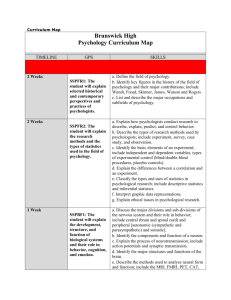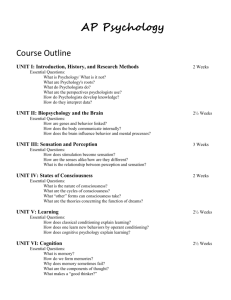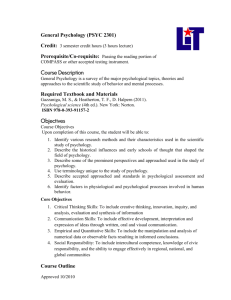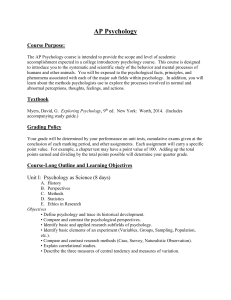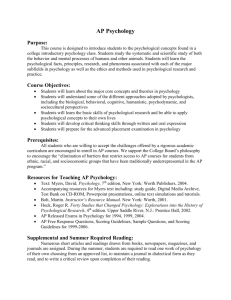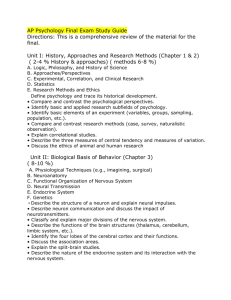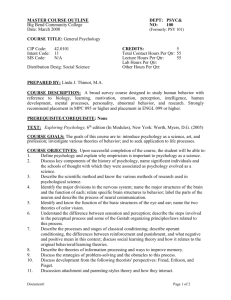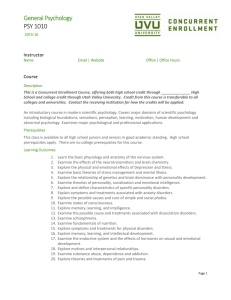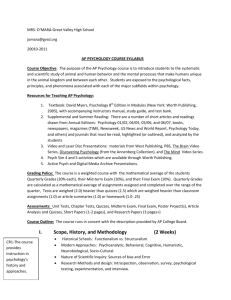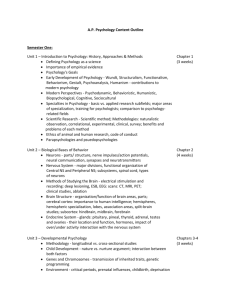Psychology Chapter Objectives
advertisement
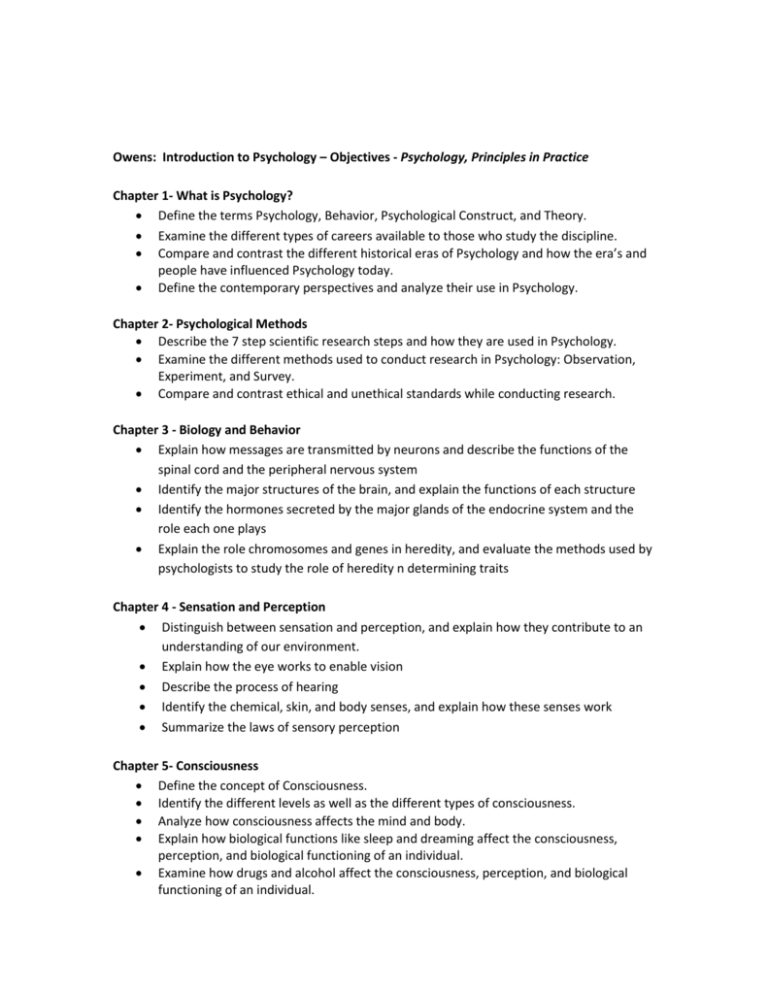
Owens: Introduction to Psychology – Objectives - Psychology, Principles in Practice Chapter 1- What is Psychology? Define the terms Psychology, Behavior, Psychological Construct, and Theory. Examine the different types of careers available to those who study the discipline. Compare and contrast the different historical eras of Psychology and how the era’s and people have influenced Psychology today. Define the contemporary perspectives and analyze their use in Psychology. Chapter 2- Psychological Methods Describe the 7 step scientific research steps and how they are used in Psychology. Examine the different methods used to conduct research in Psychology: Observation, Experiment, and Survey. Compare and contrast ethical and unethical standards while conducting research. Chapter 3 - Biology and Behavior Explain how messages are transmitted by neurons and describe the functions of the spinal cord and the peripheral nervous system Identify the major structures of the brain, and explain the functions of each structure Identify the hormones secreted by the major glands of the endocrine system and the role each one plays Explain the role chromosomes and genes in heredity, and evaluate the methods used by psychologists to study the role of heredity n determining traits Chapter 4 - Sensation and Perception Distinguish between sensation and perception, and explain how they contribute to an understanding of our environment. Explain how the eye works to enable vision Describe the process of hearing Identify the chemical, skin, and body senses, and explain how these senses work Summarize the laws of sensory perception Chapter 5- Consciousness Define the concept of Consciousness. Identify the different levels as well as the different types of consciousness. Analyze how consciousness affects the mind and body. Explain how biological functions like sleep and dreaming affect the consciousness, perception, and biological functioning of an individual. Examine how drugs and alcohol affect the consciousness, perception, and biological functioning of an individual. Examine how Freud’s theories of personality development affect the levels of consciousness within an individual. Analyze how Freud’s defense mechanisms affect the levels of consciousness within an individual. Chapter 6- Learning Explain the principles of classical, and describe some of its applications Explain the principles of operant conditioning, and describe some of its applications Discuss cognitive factors in learning, and including latent learning and observational learning Chapter 7- Memory Compare and contrast the three kinds of memory, and give an example of each kind Explain the three processes of memory Identify the 3 stages of memory, and explain how they relate to each other Describe the various kinds of forgetting, and suggest ways to improve your memory Chapter 8- Thinking and Language Explain the role that symbols, concepts, and prototypes play as units of thought Describe several methods people use to solve problems, and identify obstacles to problem solving Differentiate between deductive reasoning and inductive reasoning Analyze the strategies used in decision making Identify the basic elements of language, and summarize the stages of language development Chapter 9- Intelligence Define intelligence and explain the various theories of intelligence Identify various types of intelligence tests, and describe their uses Identify the characteristics of mental retardation and giftedness, and explain the relationship between giftedness and creativity Explain how heredity and the environment influence intelligence Chapter 10- Infancy and Childhood Explain the major theories of development Describe the physical development that occurs during infancy Describe the social development of infants and children Identify the stages in Piaget’s theory of cognitive development and in Kohlberg’s theory of moral development Chapter 11- Adolescence Identify the physical changes that occur in males and females during adolescence, and examine the psychological effects of these changes Describe the role that parents and peers generally play in the lives of adolescents Define identify formation, and describe the four categories of adolescent identify status Describe some of the important challenges that adolescents face in today’s society Chapter 12- Adulthood List the characteristics and issues of young adulthood Describe the changes that occur and issues are faced in middle adulthood Analyze the changes that occur and the concerns of people in late adulthood Explain the attitudes and issues related to death and dying Chapter 13- Motivation and Emotion List and explain four theories of motivation Describe the hunger drive Explain stimulus motives, the balance theory, and achievement motivation Describe four theories of motivation Chapter 14- Theories of Personality Explain the history, main features, and limitations of the trait theory of personality Describe the impact of the psychoanalytic theory of personality and how the theory has been modified since Sigmund Freud Describe what learning theorists believe are the influences on and motivations for behavior Explain how the humanistic approach views the role of the self and free choice in shaping behavior Discuss how the socio-cultural approach views the importance of ethnicity, gender, culture, and socioeconomic status in the development of personality Chapter 15- Psychological Tests List the purpose and characteristics of psychological tests Explain how achieve tests, aptitude tests, and interest inventories are used Identify the two kinds of personality tests, and discuss their uses Identify strategies for taking tests and ways to avoid tests anxiety Chapter 16- Gender Roles Define gender roles and gender stereotypes, and explain the difference between the two terms Describe gender differences in cognitive abilities, personality, and behavior Define gender typing and discuss several theories that explain how it may occur Explain how gender roles have changed over time, and identify the ways in which they can vary fro culture to culture Chapter 17- Stress and Health Define stress and explain some of its main causes Identify the factors that determine one’s responses to stress Explain the general adaptation syndrome, and describe the effects of stress on the immune system Identify the ways in which psychological factors contribute to headaches, heart disease, and cancer Describe some ways in which people cope with stress -Chapter 18- Psychological Disorders Define the concept of Psychological Disorders. Explain how Psychological Disorders are identified and diagnosed within the medical community. Analyze the legal rights of a mentally ill in the United States justice system Compare and contrast the traits of different categories of mental illness and identify how they are treated. Anxiety Disorders Mood Disorders Schizophrenia Dissociative Disorders Somatoform Disorders Chapter 19- Methods of Therapy Define psychotherapy, and list the advantages of each method of psychotherapy Describe the aim and major techniques of psychoanalysis Identify the primary goals and methods of humanistic therapy State the goals of cognitive therapy and behavior therapy, and describe the techniques used by cognitive and behavior therapists Describe the three major biological treatments for psychological disorders and possible side effects of these treatments Chapter 20-Social Cognition Define attitudes, and explain how they develop and how they are related to behavior Describe the influence of persuasion on people’s attitudes and behavior Identify causes of prejudice and ways in which it can be overcome List factors that influence our perceptions of other people, and explain how people use various forms of non-verbal communication Describe the role of attraction in friendships and oe relationships Chapter 21-Social Interaction Identify the ways in which membership in a group can influence individual behavior, and describe styles of group leadership Define social norms, and list the factors that lead people to conform to social norms Describe Milgram’s studies of obedience, and explain why most people tend to obey authority figures Define aggression, and summarize the various views on the causes of aggressive behavior Define altruism, and identify the factors that promote and the factors that inhibit altruistic behavior
